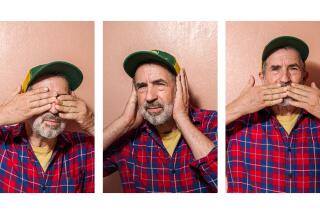The Left Hand of Darkness
I
Ray, a teenage stroke victim, is one of the tortured adolescents preoccupied by the parallel universe of animals--and “animal sadness”--in Joy Williams’ novel “The Quick and the Dead.” In this case it’s an imaginary monkey, and in his mind Ray can “feel the little monkey’s heart beating wetly beneath its gray skin . . . wordlessly expressing its situation. It, too, was not lost. It had undergone unnecessary surgery, had painfully recovered from it, had been killed piece by piece and disposed of part by part, and this had been its orbit of eternal occurrence, suffered over and over again.”
The pathos of this passage touches all the raw nerves routinely laid bare by animal rights rhetoric: the little wordless monkey, the unnecessary surgery, the suffering, the killing, the disposing. Every piece of direct mail from the Doris Day Animal League or the Humane Farming Assn. League or virtually any other animal rights group plays on our sympathies in such language, often accompanied by photos that could make a butcher wince. The emotionalism of these appeals gives rise to a host of basic questions: What are animal rights? Are they moral, legal or purely fanciful? Why should we care? Given that many societies in today’s world have an infirm grasp of human rights, are we even remotely capable of considering the rights of what are generally considered to be commodities? Just try to answer these questions without resorting to emotion and see how far you get.
In 1980, the same year that Alex Pacheco met Ingrid Newkirk and began forming a group that would eventually be known as PETA, or People for the Ethical Treatment of Animals, I was a freshman at UCLA and by happenstance met my first laboratory animal. A friend I’ll call Joe, majoring in premed, was working part-time as a laboratory assistant at the medical center and was responsible for caring for a dog that had already gone through one or more surgeries and was being given a course of drug therapy at intervals, one of which fell in the middle of the night.
When Joe asked me to go with him to see the dog, he led me through the long, empty, echoing, fluorescently lit corridors of the medical center--said to be second only to the Pentagon in its miles of hallways--past doors labeled with warning signs about radiation and other hazards, and I began to have the sense that we were entering some kind of terrifying, forbidden territory. As he unlocked the doors to the dog room, the smell and the noise were like a slap in the face. In a room with a cement floor that sloped to drains were ranks of featureless barred cages. Some were empty, but others held dogs that were either barking frenziedly or lying motionless, sick and dispirited. Joe’s dog was one of the latter, and to see such a hopeless animal, hair shaved off its stomach, was unspeakably sad. Joe was an earnest and eager premed student--his father was a surgeon--but he was so troubled by the fate of this dog, who was to be killed at the end of the experiment, that he was talking about stealing him. That’s why he’d asked me to go with him; he seemed to want me, an outsider--someone who didn’t have anything to do with the biomedical world--to validate his feelings. I didn’t know what to tell him then, and I still don’t.
Since then, in the course of writing about the animal-rights movement, I’ve seen other animal labs, including some at Bellevue Hospital in New York City, that were spotlessly clean, although the bathroom for the humans on the first floor, by the admissions desk, was smeared with feces. I’ve been given, as a pet, what’s called in the biomedical trade a “New Zealand White,” a white laboratory rabbit--a control in an experiment--who was so terrified of people that, for the first year I had her, I had long, red scratches up and down my arms. Like many Americans, I’m uncomfortable with animal research. I’m reliant on medications that were tested on animals, in my case, asthma inhalers that were (according to the product insert) tested on rabbits, golden hamsters, pregnant rats, “small young rats,” “mature rats,” minipigs, mice and dogs. Experimentation on living animals--or vivisection--is one of the most confounding moral issues of our time. The only issues more contentious involve matters of life, death, and pain: abortion and the death penalty.
II
“Who shall conceive the horrors of my secret toil, as I dabbled among the unhallowed damps of the grave, or tortured the living animal to animate the lifeless clay?” asked Dr. Frankenstein in his gothic way. Thus Deborah Rudacille, formerly a researcher at the Johns Hopkins Center for Alternatives to Animal Testing, begins her brilliant analysis in “The Scalpel and the Butterfly” of the history of the antivivisection and animal rights movements by tracing our still potent, still visceral fear of those “horrors” back to the mad scientist, the archetypal figure who is both monstrously arrogant and impotent to control the inhuman forces he lets loose on the world.
The mad scientist is still with us, in the conspiracy theories of everyone from Mike Wallace, who has spread fear about mercury amalgam fillings and other medical bugaboos on “60 Minutes,” to Louis Farrakhan, who believes that the AIDS virus was created by evil doctors. He’s still with us (always a he), playing a starring role in pop culture in everything from “The X-Files” to Jeff Goldblum’s human fly and Kevin Bacon’s invisible man. And why shouldn’t he be? The century just passing brought us, to set beside our heroes--Louis Pasteur, Jonas Salk--a host of villains: Dr. Josef Mengele, the Tuskegee syphilis scientists, and the doctors who fed radioactive oatmeal to disabled children in Massachusetts and slipped deadly isotopes into the “vitamin cocktail” they gave pregnant women. The recent spate of press reports about incompetent doctors who amputated the wrong limb or carved their initials into a woman’s abdomen carry a whiff of Mary Shelley’s haunted imagination. Science is scary, and scientists--with their white coats and cold eyes--are scarier.
“The Scalpel and the Butterfly” unpacks the power politics and anxieties that have driven antivivisection and animal rights since the beginning. Science is knowledge, and knowledge is power, and we all know what absolute power does. The more specialized, and thus the more secretive, the powers and jargon of the medical scientist have grown, the more his activities have engendered an equal and opposite reaction, especially from those who felt most vulnerable and powerless, in this case: women.
More than a century ago--infantalized by society and exposed by virtue of their reproductive role to every form of medical quackery and bungling--women of 19th-century England were exquisitely sensitive to the actual and symbolic importance of the laboratory animal. Although many of the tender-hearted Romantics (Browning, Tennyson, Carlyle, Ruskin) supported antivivisection, women were on the front lines of the movement: Queen Victoria; Anna Kingsford, an English woman and spiritualist who prevailed against the hostility of the male scientific establishment and completed a medical degree at the Ecole de Medecine in Paris without performing a single animal experiment; and Frances Powers Cobbe, an Irish antivivisectionist who nearly converted Darwin to her cause and fought for total abolition. Because society ceded them an “inherent moral superiority,” women flocked to the cause, Rudacille writes, and it “provided a seemingly heaven-sent opportunity . . . to flout male power and prerogatives at the same time that it enabled them to feel safely nurturant and feminine.” But the emotionalism of the cause--its heavy reliance on convulsive feelings of outrage--also lent itself to divisiveness within the ranks; Kingsford and Cobbe became bitter enemies, and their rivalry “weakened a movement that might have benefited from their combined efforts.”
That same emotionalism--and the discord that is its inevitable byproduct--characterizes the animal-rights movement today. The cause is riven by vicious factionalism, with groups sniping at one another over fund-raising disputes, principles and tactics: to neuter and release feral cats or euthanize them; to advocate no-kill shelters or not; to oppose hunting and trapping or tolerate them; to promote vegetarianism or not. A radical animal-rights activist I once interviewed dismissed his more moderate brethren in the humane societies as the “doggy-kitty people”; his contemptuousness perfectly captured the divide between old-fashioned protectionists (those concerned with animal welfare, represented by old-line organizations like the American Humane Assn.) and the new hard-line animal rights fundamentalists (those demanding an end to human usage of animals as food, experimental objects and entertainment, typified by organizations like PETA).
The divisions within animal rights only begin there. PETA’s “heavy-handedness,” as Rudacille calls it, has alienated any number of other radical activists and groups, in part through its mouthpiece and leader, Ingrid Newkirk, for whom no rhetoric seems too extreme. Under Newkirk, PETA has--to the dismay of some of its peers--tacitly endorsed the terrorism of the underground Animal Liberation Front, which anonymously frees minks from fur farms, sends razor blades to animal researchers and burns labs. Rudacille quotes Newkirk as saying, “When you see the resistance to basic humane treatment and to the acknowledgment of animals’ social needs, I find it small wonder that the laboratories aren’t all burning to the ground. If I had more guts, I’d light a match.”
A number of scholars, including Rudacille, have likened the animal-rights movement to a religious cult or a “moral crusade,” noting the fundamentalist, authoritarian quality of its beliefs and the zealotry of its followers. Like anti-abortion groups, animal rights is a movement that trades on visceral emotions: repulsion, revulsion, shock. Anyone who has ever recoiled from a photograph of a skinned fox or a rabbit with a bloody, open wound on its back--images thrust into the public eye by magazine advertisements or taped to card tables outside train stations--has in all likelihood been similarly assaulted by photographs of fetuses in jars wielded by those who proclaim themselves dedicated to the “right to life.” (As the all-purpose protester who appears at the end of Williams’ novel says, “Fetuses keep coming up. They’re in demand.”) Activists who stoop to such tactics feel righteously justified in doing so because they’ve decided that the horror and suffering exposed by their cause warrants it; their manipulative propaganda is coercion at emotional gunpoint.
III
But should we care? Part of the weakness of the antivivisection position has always been that, though people may be troubled by the helplessness of lab animals and the suffering they undergo, the vast majority are more than content--indeed, often desperate--to rely on the medicines and procedures produced as a result. Before his accident, Christopher Reeve spoke in 1990 at the “March for the Animals” in Washington, D.C., the largest animal-rights rally in history, and argued, moderately enough, that cosmetic testing on animals was wrong but some medical testing might be necessary. He was booed off the stage, but now that he’s a quadriplegic and an advocate for spinal cord research, much of it performed on animals, his position seems unassailable.
People also know that animals are slaughtered every day, and it’s not something that troubles them while they’re lifting hamburgers or turkey sandwiches to their mouths. Though it may be easy not to wear fur or eat veal, it’s neither easy--nor desirable, for many--to go without drugs, leather, wool, meat, dairy products. People are themselves animals. They are, in a phrase borrowed from Edward O. Wilson, “happy carnivores,” conditioned by eons of evolution and their own family upbringings and traditions to an animal-based diet and lifestyle.
Rudacille argues that the most successful animal rights campaigns have been those that gambled on a pragmatic, gradual approach. Peter Singer, the controversial philosopher and author of “Animal Liberation” (1975), the moral manifesto behind the movement, celebrates one notable pragmatist in “Ethics Into Action: Henry Spira and the Animal Rights Movement” (1998). As a social movement, animal rights is relatively understudied, so Singer’s biography of Spira (who was a close friend) serves as a portrait of an intensely practical, creative activist--not a zealot--as well as a primer in grass-roots tactics. A labor and civil rights activist who came to animal rights in middle-age, Spira had learned important lessons from union-style negotiations and boycotts. He won extraordinary victories, famously shutting down dubious cat experiments at New York’s American Museum of Natural History in 1977, moving Revlon and eventually the cosmetics industry away from standard--albeit cruel and unnecessary--tests on rabbits, and eventually focusing on ripe targets in the factory-farming arena, including Frank Perdue’s exploitative chicken plants. He convinced meatpackers to stop shackling and hoisting live cattle and the U.S Department of Agriculture to stop face-branding steers.
Spira’s modest organizations, Animal Rights International and the Coalition for Nonviolent Food, designed beautifully ironic ads, which were published in the New York Times and other papers (many of which are reproduced in Singer’s book), relying less on shock value than on more broad-minded concerns raised by factory-farming’s effect on the environment as well as conditions suffered by the animals, the low-paid workers hired to slaughter them and consumers themselves. He didn’t ask people to stop eating chicken but to think about everything and everyone harmed by chicken factories; one of his ads featured a toilet seat attached to a Kentucky Fried Chicken bucket below the words, “Do KFC’s Standards Meet Your Standards?”
Spira, who died in 1998, understood instinctually and intellectually something that the animal rights movement as a whole has often failed to understand, something Wilson calls, in his discussion of the conservation ethic in “Biophilia,” “the first law of human altruism”: “[N]ever ask people to do anything they consider contrary to their own best interests.” Like all other animals, we’re fundamentally self-serving, but that selfishness, as Spira knew, can be harnessed for change. Cosmetic companies grew eager to abandon animal testing when they realized how much money non-animal tests would save.
There are any number of selfish and altruistic reasons why the public should care about seeking alternatives to animal testing: It’s not foolproof (thalidomide was a drug that seemed harmless in animal tests); it’s expensive (particularly since the Agriculture Department recently agreed to include mice and rats under the protections of the Animal Welfare Act, raising the costs of both research and new treatments); it’s stressful for the human workers who care for the animals, as I discovered as a student; and the ultimate safety of gene-splicing, cloning and other techniques involving animals has come under fire (a controversial new book argues that AIDS may have jumped into humans from a polio vaccine made from contaminated chimpanzee cells).
IV
Animal rights is like an octopus; its tentacles touch many things at once--emergent diseases and other aspects of human health, environmental and conservation concerns, endangered species, the political power of biotechnology--that must be grappled with, whether you’re an activist, a vegetarian, a hunter, or a devotee of barbecue. But the question remains: How to care?
Joy Williams’ writings on the subject encompass the extremes. Place her 1997 essay in Harper’s on “The Inhumanity of the Animal People,” a searingly eloquent but simplistic portrayal of activists as selflessly noble (something they surely are not), next to the remarkable ambiguities of “The Quick and the Dead” for a sense of the problem.
The novel’s teenage characters, with their propensity to see the world in polarized terms, find themselves adrift in its corrupting messiness. In one scene, Alice, a young animal-loving misanthrope, imagines that the man she sees on a motorbike in the desert is stressing the bighorns, although “some people argued that there were no bighorns left.” She heaves a rock at him, and he whacks her with his helmet in return, knocking out a tooth. She notes blankly that her act “had not been a gesture without consequences.” No gesture is, and Alice comes to feel the same violent antipathy toward activists that she does toward bikers, as a strange symbolic figure called “the Candleman” appears, handing out candles to protesters regardless of what they’re protesting: “Wild horses on BLM land . . . alternative fuels, the fur trim on those big ski parkas.” “Concern is the new consumerism,” he tells her, and a fog of “healthy outrage and sorrow” threatens to engulf her even as she tries to walk away.
Yet, the reasons I still anguish over animal rights remain rooted--in spite of myself--in the sentimentalism that makes a cliche out of “caring” that gives rise to antivivisection in the first place: the sight and smell of a dog who was dying in order to test a human drug; the blood-stained saddle he’d lain in after surgery; the story my friend Joe subsequently told me, shame-faced, about a night when he and his co-workers got drunk and cut the head off a lab rat with a miniature guillotine, just for fun. Things like that have a way of staying with you, whether you want them to or not.
More to Read
Sign up for Essential California
The most important California stories and recommendations in your inbox every morning.
You may occasionally receive promotional content from the Los Angeles Times.










